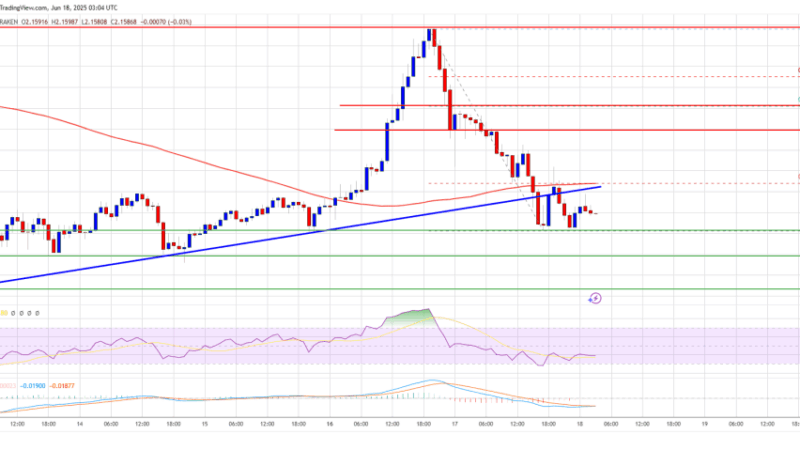Tariffs caused Bitcoin to decline less than equities and oil yet more than bonds and gold
Bitcoin continues to trade lower for April, surrendering the majority of its Q1 gains as global markets react to escalating US-China trade tensions. The move, tied to the US trade war, comes amid broader asset repricing, with Treasury yields falling, oil collapsing, and equities entering correction territory.

The above post-tariff chart captures the acute market response since President Trump’s April 2 announcement of sweeping trade penalties.
Within days, oil prices collapsed by 20.92 percent, while SPY fell 10.23 percent and Bitcoin dropped 7.34 percent. Bond prices also declined, with US10 and CN10 down 2.42 percent and 2.58 percent, respectively, reflecting upward pressure on yields.
Gold, often a traditional safe haven, retreated 2.83 percent, indicating that liquidity stress and risk-off sentiment dominated across asset classes.
Bitcoin’s relative positioning, down less than SPY and oil but more than bonds and gold, shows that despite strategic reserve narratives, it remains partially tethered to broader macro volatility under acute market stress.

Their overall performance since Donald Trump’s election win solidifies Bitcoin’s relative resilience.
Since the November 2024 US election, Bitcoin is up 11.51 percent, and gold is closely trailing at 11.09 percent. Both assets have held ground as traditional markets repriced sharply. SPY has declined 14.42 percent, and oil prices have collapsed by over 20 percent, highlighting widespread macro stress.
Meanwhile, the US and Chinese 10-year bond prices (US10 and CN10) have fallen 5.11 percent and 1.72 percent, respectively, consistent with expectations of persistent inflation or heightened issuance.
The majority of the drawdown followed President Trump’s April 2 declaration of a national emergency over trade deficits and the subsequent imposition of a 104 percent tariff on Chinese imports.
China’s response included an 84 percent tariff on US goods, a move Beijing described as non-negotiable.
BTC Correlation with Macro Deepens
Bitcoin’s performance since Trump’s inauguration initially tracked with a supportive policy environment. Public backing of crypto adoption, tokenization of reserves, and re-shoring initiatives contributed to a bullish narrative across digital assets. However, the latest data shows Bitcoin trading mostly in line with risk assets rather than decoupling from them.
The recent selloff across SPY and the reversal in Treasury yields reflect shifting expectations. Markets are beginning to price in slower growth, tighter consumption, and more defensive positioning. Yale’s Budget Lab projects a 0.9 percentage point decline in real GDP for 2025, with the average household expected to incur $3,800 in additional costs from the tariff regime.
Despite favorable long-term policy framing, Bitcoin has not escaped volatility tied to global liquidity and demand concerns. Institutional allocators appear to be reducing exposure to beta-sensitive assets, crypto included, as recession odds rise.
JPMorgan now places the probability of a global recession at 60 percent, up from 40 percent before the April announcements. Goldman Sachs raised its US-specific projection to 45 percent. JPMorgan’s annual letter also cautioned that prolonged tariffs may contribute to persistent inflation, asset volatility, and reduced investment confidence.
Global Bond Divergence Narrows Bitcoin’s Safe-Haven Window
While US Treasury yields have reversed sharply, China’s sovereign bond market is reflecting different stress signals. The China 10-year yield is down to 1.65 percent, dropping 65 basis points year over year.
Trading Economics data also shows consistent yield declines across the 2Y, 5Y, and 30Y curves. These moves imply deflationary pressure, weak external demand, and limited domestic growth rebound potential.
As Citi reported, China’s GDP forecast has been cut from 4.7 percent to 4.2 percent for 2025. Kaiyuan Securities projects that US tariffs may reduce Chinese exports by nearly a third, reducing total exports by 4.5 percent and dragging growth by over a percentage point.
With both Western and Chinese sovereign curves pricing in downside growth risk, Bitcoin’s role as a global reserve hedge becomes more complicated.
Institutional portfolios may hold back on discretionary allocation until liquidity stabilizes or policy clarity returns.
Trump’s framing of Bitcoin as a reserve-grade digital commodity continues to resonate with parts of the domestic crypto ecosystem, but implementation remains unclear. For now, investors appear to be watching macro signals more than political signaling.
Bitcoin Outlook in Context of Recession Risk
The structural narrative surrounding Bitcoin as a geopolitical hedge, inflation buffer, or programmable reserve asset remains intact.
However, in periods of macro stress, correlations tend to increase across all risk markets. The latest price action indicates that Bitcoin is not yet viewed as a risk-off asset under liquidity duress.
BTC may still find policy tailwinds if the administration accelerates Bitcoin-native initiatives, introduces digital treasury issuance, or formalizes sovereign Bitcoin holdings. Until then, market participants are trading the asset through a macro lens. Price behavior remains closely tied to risk conditions, recession modeling, and cross-asset liquidity.
Brent crude oil has fallen more than 20 percent since late March, with forward spreads narrowing and surplus pricing increasing. Consumer retrenchment, reduced export demand, and pressure on manufacturing margins all feed into broader market repricing.
Bitcoin, as part of the broader allocation spectrum, remains sensitive to these shifts.
Year-to-date Bitcoin is actually one of the worst-performing assets, second only to oil.

The divergence illustrates how Bitcoin and gold have so far absorbed trade war volatility more effectively than oil, equities, or sovereign debt markets, suggesting that Bitcoin has drawn relative strength even as global liquidity deteriorates.
However, no asset can compare to gold in 2025 up 16%.
The post Tariffs caused Bitcoin to decline less than equities and oil yet more than bonds and gold appeared first on CryptoSlate.



